RS Aggarwal Class 6 Math Seventh Chapter Decimals Exercise 7A Solution
EXERCISE 7A
(1) Write each of the following in figures:
(i) Fifty-eight point six three
Ans: 58.63
(ii) One hundred twenty-four point four two five
Ans: 124.425
(iii) Seven point seven six
Ans: 7.76
(iv) Nineteen point eight
Ans: 19.8
(v) Four hundred four point zero four four
Ans: 404.044
(vi) Point one seven three
Ans: 0.173
(vii) Point zero one five
Ans: 0.015
(2) Write the place value of each digit in each of the following decimals:


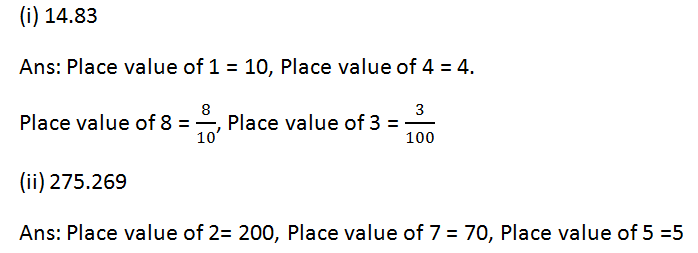
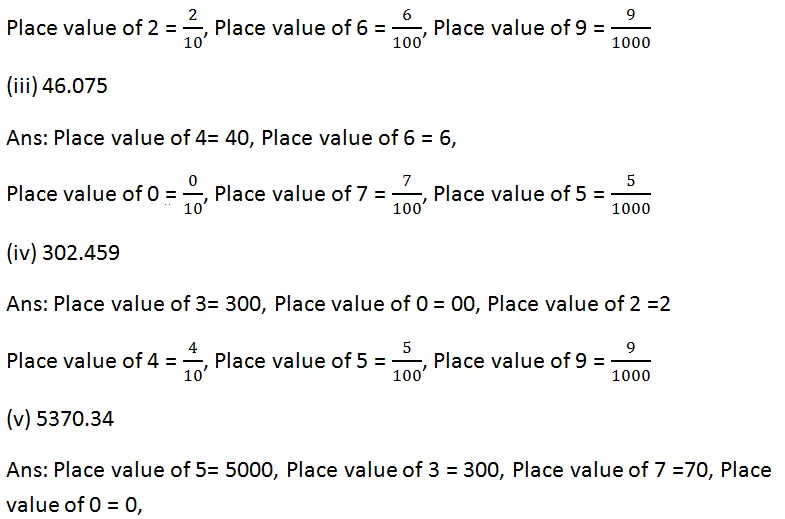
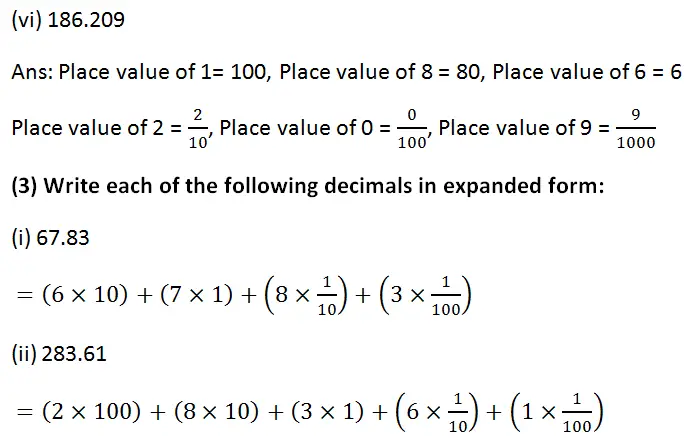

(4) Write each of the following in decimal form:
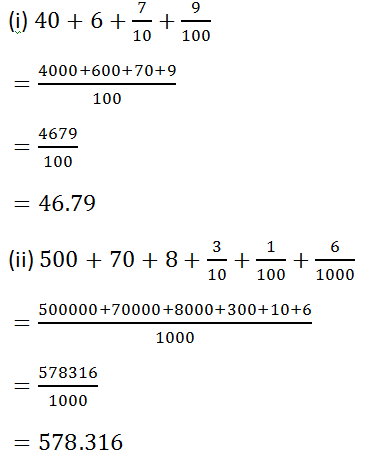
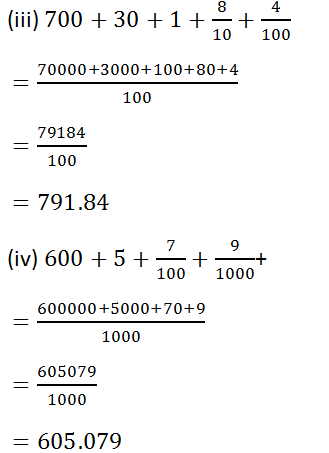
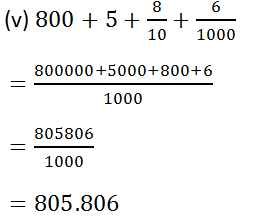
(5) Convert each of the following into like decimals:
(i) 7.5, 64.23, 0.074
Solution: In the given numbers, the maximum number of decimal places is 3. So, we convert each one of the given numbers into having 3 decimal places by annexing suitable number of zeros to the extreme right of the decimal part.
7.5 = 7.500, 64.23 = 64.230, 0.074 = 0.074
Thus, 7.500, 64.230, 0.074 are the required like decimals.
(ii) 0.6, 5.937, 2.36, 4.2
Solution: In the given numbers, the maximum number of decimal places is 3. So, we convert each one of the given numbers into having 3 decimal places by annexing suitable number of zeros to the extreme right of the decimal part.
0.6 = 0.600, 5.937 = 5.937, 2.36 = 2.360, 4.2 = 4.200
Thus, 0.600, 5.937, 2.360, 4.200 are the required like decimals.
(iii) 1.6, 0.07, 3.58, 2.9
Solution: In the given numbers, the maximum number of decimal places is 2. So, we convert each one of the given numbers into having 2 decimal places by annexing suitable number of zeros to the extreme right of the decimal part.
1.6 = 1.60, 0.07 = 0.07, 3.58 = 3.58, 2.9 = 2.90
Thus, 1.60, 0.07, 3.58, 2.90 are the required like decimals.
(iv) 2.5, 0.63, 14.08, 1.637
Solution: In the given numbers, the maximum number of decimal places is 3. So, we convert each one of the given numbers into having 3 decimal places by annexing suitable number of zeros to the extreme right of the decimal part.
2.5 = 2.500, 0.63 = 0.630, 14.08 = 14.080, 1.637 = 1.637
Thus, 2.500, 0.630, 14.080, 1.637 are the required like decimals.
(6) Fill in each of the places holders with the correct symbol > or <:
(i) 84.23 ….. 76.35
Solution: The given decimals are 84.23 and 76.35.
Let us compare their whole-number parts.
Clearly, 84>76
So, 84.23>76.35
(ii) 7.608 …… 7.68
Solution: Converting the given decimals into like decimals, they become
7.608 and 7.68. The whole-number parts of these numbers are equal.
So, we compare their hundreds digits.
Clearly, 0 hundreds < 8 hundreds.
Hence, 7.608<7.68.
(iii) 8.34 ….. 8.43
Solution: Converting the given decimals into like decimals, they become
8.34 and 8.43. The whole-number parts of these numbers are equal.
So, we compare their tenths digits.
Clearly, 3 tenths < 4 tenths
Hence, 8.34 < 8.43
(iv) 12.06 …….. 12.006
Solution: Converting the given decimals into like decimals, they become
12.06 and 12.006. The whole-number parts of these numbers are equal.
So, we compare their hundreds digits.
Clearly, 6 hundreds < 0 hundreds.
Hence, 12.06 > 12.006.
(v) 3.85 …… 3.805
Solution: Converting the given decimals into like decimals, they become
3.85 and 3.805. The whole-number parts of these numbers are equal.
So, we compare their hundreds digits.
Clearly, 5 hundreds < 0 hundreds.
Hence, 3.85 > 3.805.
(vi) 0.97 …… 1.07
Solution: The given decimals are 0.97and 1.07.
Let us compare their whole-number parts.
Clearly, 0 < 1
So, 0.97 < 1.07.
(7) Arrange the following decimals in ascending order:
(i) 5.8, 7.2, 5.69, 7.14, 5.06
Solution: Converting the given decimals into like decimals, we get them as
5.80, 7.20, 5.69, 7.14, 5.06
Clearly, 5.06 < 5.69 < 5.80 < 7.14 < 7.20
(ii) 0.6, 6.6, 6.06, 66.6, 0.06
Solution: Converting the given decimals into like decimals, we get them as
0.60, 6.60, 6.06, 66.60, 0.06
Clearly, 0.06 < 0.60 < 6.06 < 6.60 < 66.60
(iii) 6.54, 6.45, 6.4, 6.5, 6.05
Solution: Converting the given decimals into like decimals, we get them as
6.54, 6.45, 6.40, 6.50, 6.05
Clearly, 6.05 < 6.40 < 6.45 < 6.50 < 6.54
(iv) 3.3, 3.303, 3.033, 0.33, 3.003
Solution: Converting the given decimals into like decimals, we get them as
3.300, 3.303, 3.033, 0.330, 3.003
Clearly, 0.330 < 3.003 < 3.033 < 3.300 < 3.303
(8) Arrange the following decimals in descending order:
(i) 7.3, 8.73, 73.03, 7.33, 8.073
Solution: Converting the given decimals into like decimals, we get them as
7.300, 8.730, 73.030, 7.330, 8.073
Clearly, 73.03 > 8.730 > 8.073 > 7.33 > 7.3
(ii) 3.3, 3.03, 30.3, 30.03, 3.003
Solution: Converting the given decimals into like decimals, we get them as
3.300, 3.030, 30.300, 30.030, 3.003
Clearly, 30.3 > 30.03 > 3.3 > 3.03 > 3.003
(iii) .7, 7.2, 2.27, 2.72, 2.02, 2.007
Solution: Converting the given decimals into like decimals, we get them as
2.700, 7.200, 2.270, 2.720, 2.020, 2.007
Clearly, 7.2 > 2.72 > 2.7 > 2.27 > 2.02 > 2.007
(iv) 8.88, 8.088, 88.8, 88.08, 8.008
Solution: Converting the given decimals into like decimals, we get them as
8.880, 8.008, 88.800, 88.080, 8.008
Clearly, 88.8 > 88.08 > 8.88 > 8.088 > 8.008
For more exercise solutions, Click Below –
Leave a Reply